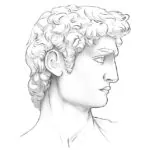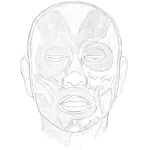Torso Muscles Anatomy

The muscles of the torso shape a person’s appearance in many ways. Muscles of the torso, as well as muscles in the arms or legs, can give the impression of a thin or athletic person.
But, above all, these muscles are of great physiological importance. The muscles of the back and abdomen help to keep the spine in an upright position and serve as reliable protection for the abdominal organs. The muscles of the chest help to make various movements with the arms, and these muscles also participate in breathing, setting the chest in motion.
We analyze precisely the plastic anatomy, that is, the structure of precisely those anatomical structures that form the contour of the body. Therefore, today we will show you the superficial muscles of the back, chest, and abdomen.
Pectoral Muscles
The pectoral muscles are divided into superficial and deep. The superficial pectoral muscles attached to the bones of the upper limb. These muscles move the arm. The deep muscles are located between the ribs and move the ribcage, helping to breathe.
Pectoralis Major
The most prominent pectoral muscle is the pectoralis major. This surface layer muscle is located just under the skin, so it is very visible in athletic people. Slightly higher and lateral to the pectoralis major muscle is the deltoid muscle of the shoulder. Below are the abdominal muscles and the serratus anterior muscle.
The pectoralis major muscle starts from the clavicle, from the anterior surface of the sternum and cartilage of 2-7 ribs, as well as from the front wall of the rectus sheath. Below we will definitely analyze what the rectus abdominis sheath is.
The pectoralis major muscle attaches to the greater tubercle of the humerus. Remember, all the superficial muscles of the chest drive the bones of the upper limb.

Serratus Anterior Muscle
The long parts of this muscle cover the ribs. It is a fairly powerful muscle that sits superficially, so you can see the serratus anterior muscle in athletic people with a small amount of subcutaneous fat. The most important feature that distinguishes the serratus anterior muscle from many other muscles associated with the ribs is the location of the muscle parts just above the ribs, and not between them.
Serratus anterior muscle begins on the outer surface of 1-9 ribs and is attached to the medial edge and lower corner of the scapula.

This group also includes the pectoralis minor muscle and the subclavian muscle, which we can only see if the pectoralis major muscle is removed, so these muscles are not particularly important for plastic anatomy.
Muscles of the Back
The muscles of the back are a very large group of muscles, the main tasks of which are to control the movements of the spine and maintain the spine in an upright position. The back muscles in humans have developed very powerfully due to upright posture. The muscles of the back lie in several layers, and we will only disassemble those muscles that form the contour of the body.
Trapezius Muscle
This is a paired muscle, and if we consider only the left or only the right trapezius muscle, we will see a triangular muscle fiber. If we look at the contours of both muscles together, then we really see a figure that looks like a trapezoid.
The trapezius muscle is located under the skin. It is noticeable when you strain your back, raise your shoulders, and tilt your head back slightly. In this position, this muscle contours even in people with a normal physique.
The trapezius muscle starts from the occipital bone of the skull and from the spinous processes of the cervical and thoracic vertebrae. We’re talking about a fairly broad muscle, actually. This muscle attaches to the acromion of the scapula, the spine of the scapula, and to the acromion of the clavicle.
Latissimus Dorsi Muscle
This is another powerful and large superficial paired back muscle. The latissimus muscles cover the entire back of the torso like a corset. In athletic people, this muscle is clearly visible even from the front.
These areas are sometimes referred to as wings. The developed latissimus dorsi muscle in combination with the deltoid muscles and pectoralis major muscles forms a masculine type of figure with a very wide upper body and a narrow pelvis.
The powerful latissimus dorsi muscle begins from the pelvic bones, ribs, and vertebrae. The latissimus muscle is attached to the crest of the lesser tubercle of the humerus. The latissimus dorsi muscle strengthens the torso, participates in breathing, and rotates the shoulder. The latissimus dorsi muscle is well known to fans of workout because it is this muscle that works when pulling up on the horizontal bar.

Erector Spinae Muscles
This muscle occupies a deep position, that is, it is covered by the skin, fascia, and other muscles. However, the muscle that straightens the spine is very powerful and large, so we can see it in a living person.
Massive bundles of this muscle start from the lumbar-thoracic fascia, the angles of the ribs, and spinous processes of the lumbar and thoracic vertebrae, as well as from the posterior surface of the sacrum. They are attached to the mastoid process of the skull, to the occipital bone and to the transverse processes of the overlying vertebrae
The muscle that straightens the spine holds the vertebral column in an upright position and unbends it, pulls the head back, and tilts it diagonally. Also, this muscle is involved in breathing, setting the chest in motion.

Abdominal Muscles
The abdominal muscles are divided into three categories – anterior, lateral, and posterior. For plastic anatomy, two muscles are of particular importance, which forms the anterior and lateral walls.
Rectus Abdominis Muscle
This muscle looks like a long, wide strap that extends from the pubic symphysis to the costal angle. Throughout its entire length, the rectus abdominis muscle is intersected by several bridges. This is how rectangular areas are formed, which are called abs.
The rectus abdominis muscle starts from the pubic symphysis and attaches to the outer surface of the cartilage of the 7 lower ribs. The function of the rectus abdominis muscle is flexion of the spinal column, that is, the opposite effect relative to the erector spinal muscle. With the body fixed, the rectus abdominis muscle raises the legs and brings them closer to the body. This movement is a very popular workout abdominal exercise.

Abdominal External Oblique Muscle
The fibers of this muscle are like a muscle corset that is stretched between the ribs and the pelvis. The external oblique muscle of the abdomen starts from the outer surface of the eight lower ribs, literally intertwining between the bundles of the serratus anterior muscle. This further emphasizes the convexity and relief of the serratus anterior muscle.
The external oblique muscle is attached to the pubic tubercle and iliac crest. The area of the external oblique muscle that stretches between these two bony formations is called the inguinal ligament.
The abdominal external oblique muscle, like the rectus muscle, is clearly visible in people with a low content of subcutaneous fat or with very developed muscle mass.

In this illustration, we can see the rectus abdominis muscle against the background of the deeper abdominal muscles:

Chest Topography
Chest Borders
The border that separates the chest from the neck runs from the jugular notch of the sternum along the superior edges of the clavicles and the acromioclavicular joints. Further, the line passes to the back and continues to the spinous process of the 7th cervical vertebra.
The lower border of the chest is projected onto a line that goes from the xiphoid process of the sternum along the costal arch to the spinous process of the 12th thoracic vertebra.
The lateral border of the chest is the deltoid-thoracic groove, which separates the chest from the free upper limb.
Chest Regions
In topographic anatomy, the chest has anterior and posterior walls. Many anatomists do not consider the back as a region, dividing it into the back wall of the chest and the back wall of the abdomen.
Presternal Region
The boundaries of the pre-sternal region coincide with the boundaries of the sternum.
Pectoral Region
In athletic people, the boundaries of the pectoral region coincide with the boundaries of the pectoralis major muscle. More reliable landmarks for the pectoral area are:
- The upper edge of the clavicle – the upper border;
- The lower edge of the 6th rib – the lower border;
- The lateral edge of the sternum – the medial border;
- Deltoid-thoracic groove – lateral border.
Substernal Region
The substernal region is bounded:
- Above – by the 6th rib (in athletic people, this border coincides with the contour of the pectoralis major muscle);
- Bottom – by the costal arch;
- Medial – by the lateral edge of the sternum;
- Laterally – by the middle axillary line.
Scapular Region
The scapular region has the following boundaries:
- Top – coincides with the upper border of the chest (see above);
- Lower – a horizontal line is drawn through the lower corner of the scapula;
- Medial – a line that is drawn through the medial edge of the scapula;
- Lateral – the posterior edge of the deltoid muscle and the middle axillary line.
Subscapular Region
The scapular region has the following boundaries:
- Upper – a line drawn through the lower corner of the scapula;
- Lower – the 12th rib;
- Medial – the paravertebral line;
- Lateral – the middle axillary line.
Vertebral Region
The vertebral region has the following boundaries:
- Top – coincides with the upper border of the chest (see above);
- Lower – a horizontal line, which is drawn through the spinous process of the 12th thoracic vertebra;
- Lateral – the paravertebral lines.

Abdominal regions
Like the chest, the abdomen has front and back walls, with the back wall corresponding to the lower half of the back.
The borders of the abdomen.
Above, the abdomen is bounded by the lower edges of the 10th pair of ribs. From below, the abdomen is bordered by the small pelvis. The conditional border between the abdomen and the small pelvis is the terminal line, which we cannot see on a living person.
The anterior abdominal wall is divided into three areas – epigastrium, mesogastrium, and hypogastrium. To draw the boundaries of these areas, we need to draw two conventional horizontal lines. The upper line is drawn through the lowest points of the 10th pair of ribs, and the lower one through the spina iliaca anterior superior. Thus, the upper region is the epigastrium, the middle is the mesogastrium, and the lower is the hypogastrium.
The back wall of the abdomen is formed by the muscles of the lower back and the portion of the spine that extends into the lumbar region. The upper border of the lumbar region is the lower edge of the 12th rib, and the lower border of the lumbar region is the iliac crest.








